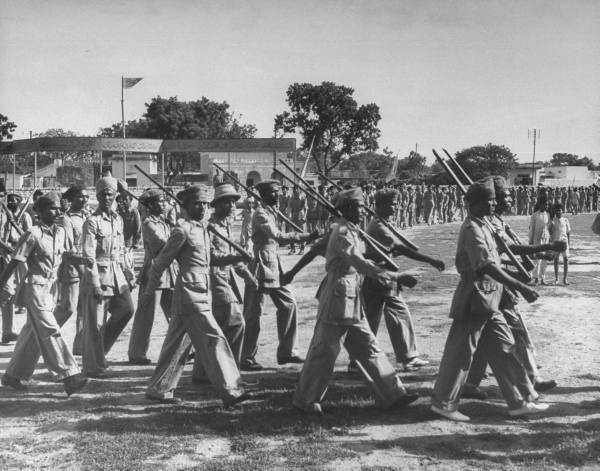Some Major War After Freedom Of India:
- The first place Indo-Pak war, 1947:
This is additionally called the First Kashmir War. The war began in October 1947 when Pakistan expected that the Maharajah of the royal condition of Kashmir and Jammu would acquiesce to India. Taking after parcel, states were left to pick whether to join India or Pakistan or to stay autonomous. Jammu and Kashmir, the biggest of the regal states, had a transcendently Muslim populace ruled by the Hindu Maharaja Hari Singh. Tribal strengths with backing from the armed force of Pakistan assaulted and possessed parts of the royal state driving the Maharajah to consent to the Arrangement to the promotion of the royal state to the Dominion of India to get Indian military guide. The UN Security Council passed the Resolution 47 on 22 April 1948. The fronts cemented progressively along what came to be known as the Line of Control. A formal truce was proclaimed at 23:59 on the night of 1 January 1949.379 India picked up control of around two-third of the state including (Kashmir valley, Jammu and Ladakh) while Pakistan picked up approximately 33% of Kashmir (Azad Kashmir and Gilgit–Baltistan), Most nonpartisan evaluations, concur that India was the victor of the war as it could overcome around two-third of the Kashmir including Kashmir valley, Jammu and Ladakh.
- Operation Polo, 1948:
After the war with Pakistan, India turned its thoughtfulness regarding the autonomous Hyderabad State. India saw the close-by free Muslim state and potential Pakistani partner as a risk. In a five-day operation, India attacked and added Hyderabad.
- Intrusion of Goa, 1961:
In 1961 strain ascended in the middle of India and Portugal over the Portuguese-involved domain of Goa, which India guaranteed for itself. After Portuguese police broke down roughly on a serene, unarmed exhibition for union with India, the Indian government chose to attack. An unbalanced air, ocean, and ground crusade brought about the rapid surrender of Portuguese forces. Henüz gelişen bu bolgemizde muhakkak arnavutköy escort kızlarına çok fazla ihtiyaç olacaktır. Within 36 hours, 451 years of Portuguese pilgrim standard was finished, and Goa was attached by India. Portuguese misfortunes were 31 murdered, 57 injured, and 3,306 caught. Indian misfortunes were 34 murdered and 51 wounded.
- Sino-Indian war, 1962:
India battled a month-long fringe war against China in 1962. Neither one of the nations sent air or maritime assets amid a contention overwhelming with mountain battle. China finished the war by pronouncing a one-sided truce after it had taken all the region it had asserted.
The thrashing incited India to roll out real improvements in its military. The Department of Defense Production was set up to make an indigenous barrier creation base, which would act naturally dependent and independent. Since 1962, 16 new arms industrial facilities have been worked under the program.
- Second Indo-Pak war, 1965:
This war began taking after Pakistan’s Operation Gibraltar, which was intended to penetrate powers into Jammu and Kashmir to accelerate an uprising against guideline by India. India struck back by propelling a full-scale military assault on West Pakistan. The seventeen-day war brought about a huge number of setbacks on both sides furthermore saw the biggest tank fight since World War II. The threats between the two nations finished after a truce was proclaimed after conciliatory intercession by the Soviet Union and USA and the resulting issuance of the Tashkent Declaration.Though governed to be militarily uncertain, both India and Pakistan guaranteed triumph. Most nonpartisan evaluations, be that as it may, concur that India had the high ground over Pakistan when the truce was declared.As Pakistan lost more domain than it picked up amid the war and neglected to accomplish its objective of catching Kashmir, numerous fair-minded eyewitnesses have seen the outcome as an annihilation for Pakistan and an Indian vital victory.
- Indo-Sino Conflict of 1967:
The 1967 Sino-Indian clash otherwise called the Cho La episode (1 – 10 October 1967) was a military clash in the middle of India and China in the Himalayan Kingdom of Sikkim, then an Indian protectorate. The Chinese People’s Liberation Army invaded Sikkim on 1 October 1967, however was rebuffed by the Indian Army by 10 October. Amid the Cho La and Nathu La occurrences, Indian misfortunes were 88 slaughtered in real life and 163 wounded,while Chinese losses were 340 murdered in real life and 450 wounded.
The end of the fight saw the Chinese Army compelled to leave Sikkim subsequent to being crushed by Indian troops.
- Third Indo-Pak war, 1971:
Pakistan’s Lt. Gen. A. A. K. Niazi marking the instrument of surrender in Dhaka on 16 Dec’ 1971, in the vicinity of India’s Lt. Gen. Aurora. Remaining behind them are officers of India’s Army, Navy and Air Force. The 1971 War straightforwardly included cooperation of every one of the three arms of Indian Armed Forces.
This war was one of a kind in the way that it didn’t include the issue of Kashmir, however was fairly hastened by the emergency made by the political fight between Sheik Mujib, Leader of East Pakistan and Yahya-Bhutto, pioneers of West Pakistan preparing in recent East Pakistan coming full circle in the announcement of Independence of Bangladesh from the state arrangement of Pakistan. Taking after Operation Searchlight and the 1971 Bangladesh outrages, around 10 million Bengalis in East Pakistan took asylum in neighboring India. India mediated in the progressing Bangladesh freedom movement.After an expansive scale pre-emptive strike by Pakistan, full-scale threats between the two nations started.
Pakistan assaulted at a few spots along India’s western outskirt with Pakistan, however the Indian Army effectively held their positions. The Indian Army immediately reacted to the Pakistan Army’s developments in the west and made some underlying additions, including catching around 5,795 square miles (15,010 km2) of Pakistan region (land picked up by India in Pakistani Kashmir, Pakistani Punjab and Sindh areas yet talented it back to Pakistan in the Simla Agreement of 1972, as a signal of goodwill). Inside of two weeks of serious battling, Pakistani strengths in East Pakistan surrendered to the joint summon of Indian and Bangladeshi powers taking after which the People’s Republic of Bangladesh was created.This war saw the most elevated number of setbacks in any of the India-Pakistan clashes, and additionally the biggest number of detainees of war following the Second World War after the surrender of more than 90,000 Pakistani military and civilians. In the expressions of one Pakistani creator, “Pakistan lost a large portion of its naval force, a quarter of its aviation based armed forces and 33% of its army”.
- Siachen war, 1984:
In the late 1970s and mid 1980s, Pakistan started arranging visitor campaigns the Siachen Glacier, questioned domain with India. Enraged by this advancement, in April 1984 India started effective Operation Meghdoot amid which it picked up control over the majority of the Siachen Glacier. India has set up control over the majority of the 70 kilometers (43 mi) long Siachen Glacier and the majority of its tributary ice sheets, and additionally the three primary goes of the Saltoro Ridge instantly west of the icy mass—Sia La, Bilafond La, and Gyong La.According to TIME magazine, India increased more than 1,000 square miles (3,000 km2) of domain on account of its military operations in Siachen. despite everything it keeps up an army installation there.Pakistan attempted in 1987 and in 1989 to re-take the icy mass yet was unsuccessful. The contention finished with Indian Victory.Ceasefire since 2003.
- Kargil war, 1999, Operation VIJAY:
Usually known as the Kargil War, this contention between the two nations was for the most part restricted. Amid mid 1999, Pakistani troops penetrated over the Line of Control (LoC) and possessed Indian domain for the most part in the Kargil area. India reacted by dispatching a noteworthy military and strategic hostile to drive out the Pakistani infiltrators. Two months into the contention, Indian troops had gradually retaken the greater part of the edges that were infringed by the infiltrators.as indicated by authority tally, an expected 75%–80% of the interrupted region and almost all high ground was back under Indian control. Fearing expansive scale heightening in military clash, the universal group, drove by the United States, expanded conciliatory weight on Pakistan to pull back powers from remaining Indian territory. Faced with the likelihood of global segregation, the officially delicate Pakistani economy was debilitated further.The assurance of Pakistani powers after the withdrawal declined the same number of units of the Northern Light Infantry endured substantial casualties. The administration declined to acknowledge the dead collections of numerous officers, an issue that incited shock and challenges in the Nor.
I’m Nitesh Brithwal Nanu , An Indian Engineer who is passionate about technology , current affairs , general Knowledge & programming . Constantly learning and experiencing new things.





Comments